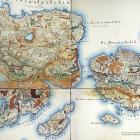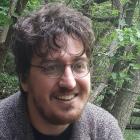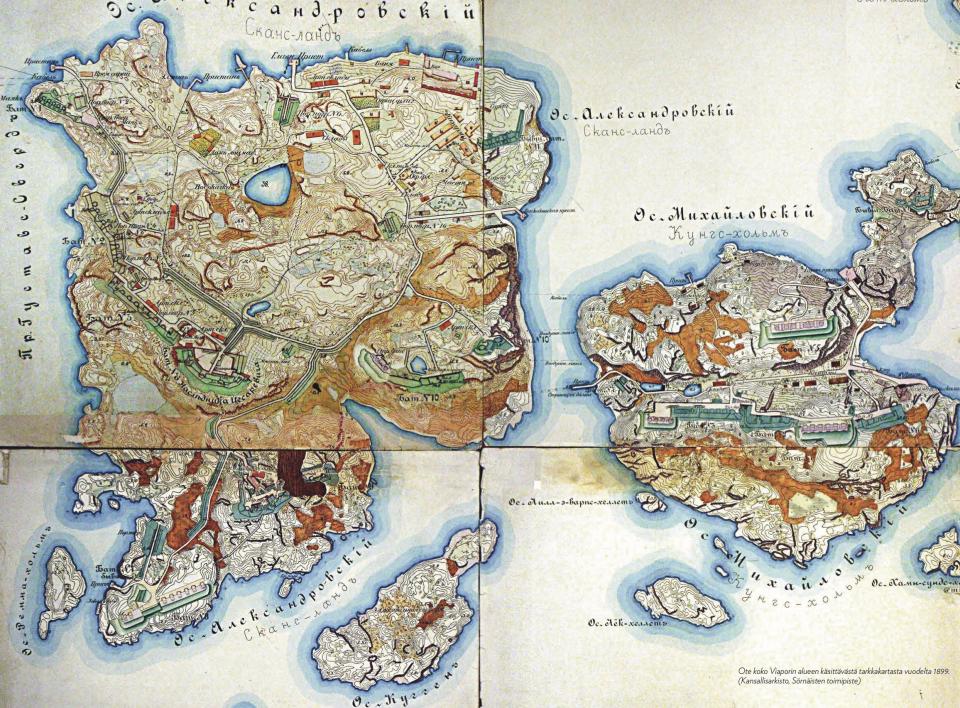
Map of Vallisaari (left) and Kuninkaansaari (right) from 1899, showing the various military buildings, housing, ammunition storages, and batteries. Most of these structures are today in ruins taken over by the wilderness.
Map of Vallisaari (left) and Kuninkaansaari (right) from 1899, showing the various military buildings, housing, ammunition storages, and batteries. Most of these structures are today in ruins taken over by the wilderness.
Courtesy of National Archives Finland.
 This work is licensed under a Creative Commons Public Domain Mark 1.0 License.
This work is licensed under a Creative Commons Public Domain Mark 1.0 License.
The history of Vallisaari is replete with natural and infrastructural entanglements. In between military occupations and abandonments, the island was transformed into an ecological paradise, but is now to be drawn back into the sphere of infrastructure through cultural and touristic development. Its transformations—whether for the worse or the better—have depended on regional geopolitics, location, and natural geography. When one traces this history, one finds an intermittent occupation of the environment by military structures, followed by abandonment, and subsequent recovery. Forthcoming international art events such as the Helsinki Biennial, inherently needing water, data, and energy to sustain them, also operationalize the island into infrastructure. Studying these natural and infrastructural transformations will be useful for any comprehensive study in the future to map the complex environmental history of Vallisaari.
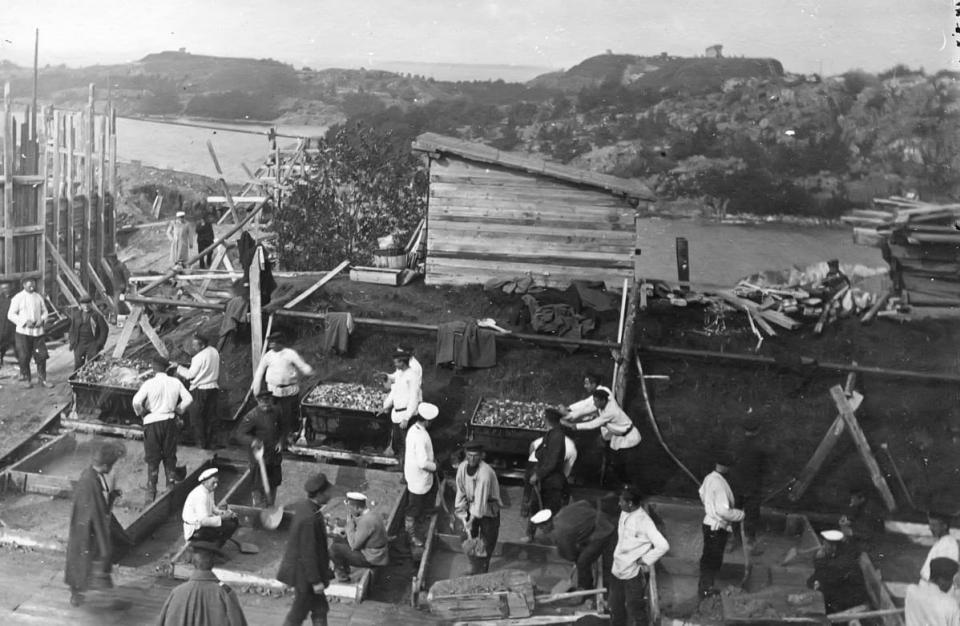
The construction of a battery in progress on the island of Kuninkaansaari in 1900. According to Enqvist and Eskola, the increased tension before the Crimean War (1854–1856) resulted in the construction of a chain of batteries on Vallisaari and Kuninkaansaari in 1853. The work continued throughout the rest of the nineteenth century, with earthen batteries gradually substituted by stone and concrete batteries. These derelict ramparts are today fertile grounds for a rich biodiversity of plants and animal species.
The construction of a battery in progress on the island of Kuninkaansaari in 1900. According to Enqvist and Eskola, the increased tension before the Crimean War (1854–1856) resulted in the construction of a chain of batteries on Vallisaari and Kuninkaansaari in 1853. The work continued throughout the rest of the nineteenth century, with earthen batteries gradually substituted by stone and concrete batteries. These derelict ramparts are today fertile grounds for a rich biodiversity of plants and animal species.
Unknown photographer, 1900.
Courtesy of Sotamuseo, Finland.
 This work is licensed under a Creative Commons Public Domain Mark 1.0 License.
This work is licensed under a Creative Commons Public Domain Mark 1.0 License.
Vallisaari remained isolated by military use for centuries. Located close to the mainland, along with Suomenlinna island, Vallisaari and the neighboring Kuninkansaari served as fortifications during the Swedish reign (in the late thirteenth century to 1808) and the Russian empire (1809–1917) leading up to the new Finnish nation. During this time, a variety of military structures were constructed, abandoned, and rebuilt by the respective governments. The role of the two islands as military infrastructure continued after Finland became independent in 1917. Weapons and explosives were stored by the Finnish Defence Forces on Vallisaari until recently. In addition, a residential community of 300 residents flourished in the 1950s. In the years following, the military reduced its operations on the island and, in 2008, the Finnish Defence Forces announced their departure from the island. Subsequently, in 2013, National Parks Finland initiated a project to prepare the opening of the islands to visitors. Vallisaari was finally opened to the public in 2016, as a wilderness among the cannons.
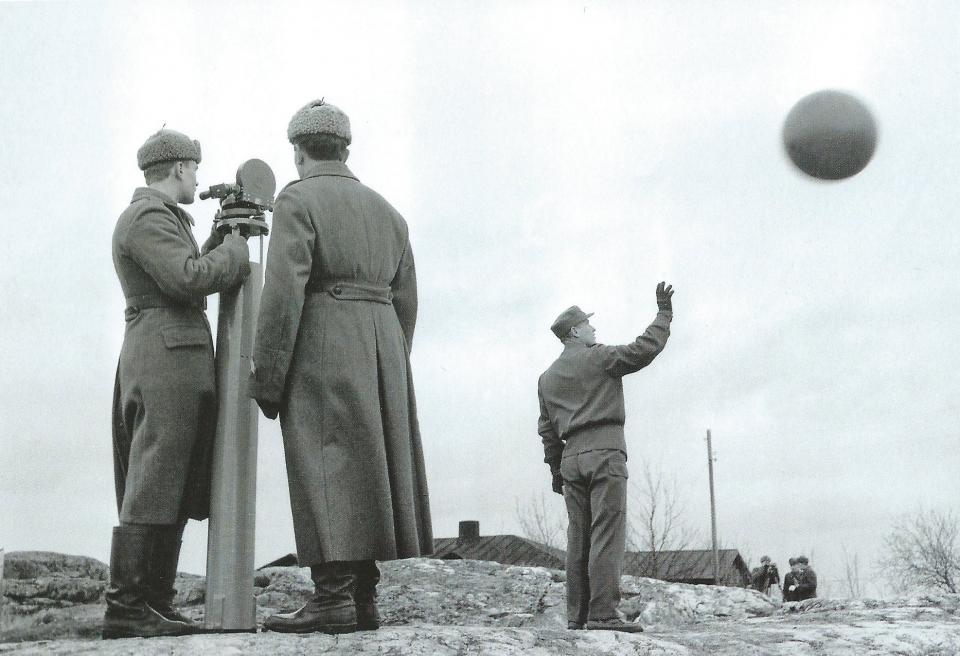
The launch of a weather balloon at the Vallisaari military meteorological station in 1962. According to Enqvist and Eskola, the task of the centre was to train conscripts as well as regular persons in the skills of meteorology.
The military history of Vallisaari is well documented and discussed, but its environmental history less so. In the Middle Ages, it was known as Lampisaari or Pond island, for the numerous fresh-water ponds from which sea pilots replenished their drinking water supplies. During the Swedish reign, Vallisaari had nominal fortifications, as compared to the neighboring island of Suomenlinna. According to National Parks Finland, cattle grazed on the island, and the forests were cut down for firewood. Thus, by the beginning of the twentieth century, the island had been left barren. Still, nature and the military existed side by side, with the island serving as an ammunition dump as well as having a meteorological station. This continued until the gradual abandonment of the island when the wilderness took over, leading to a rich diversity of plant, animal species, and habitats.
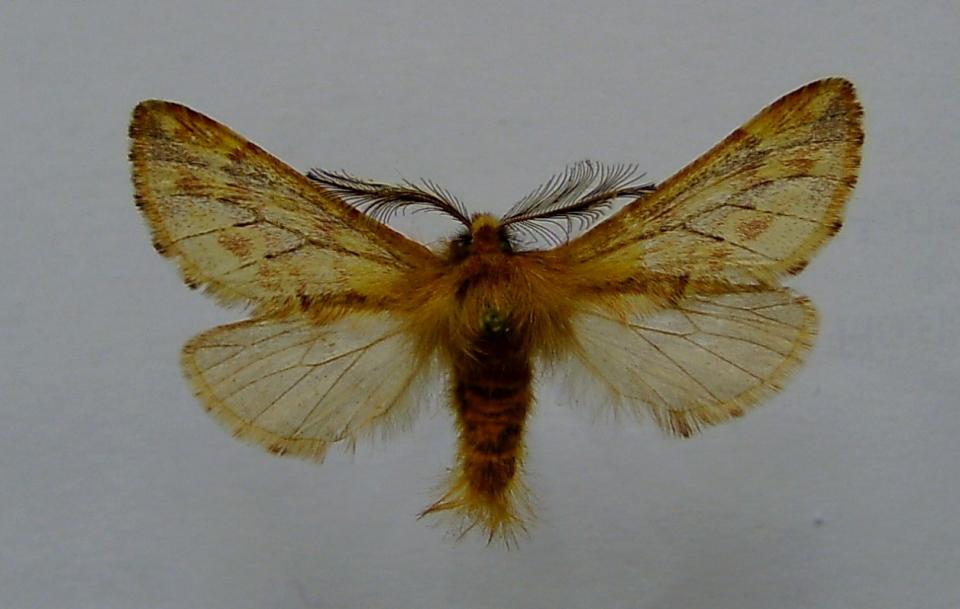
Vallisaari is a great place for the Plumed Prominent (Ptilophora plumigera) because of the warm maple-growing valleys protected by the high cliffs. Both larvae and butterflies are protected from strong winds and the proximity of the sea compensates for weather variations and spring frosts. Some sources have mentioned that the species prefers maple forests growing in limestone areas. This could explain the exceptional abundance of the species in Vallisaari, where the concrete construction used in the old fortifications drains the soil, which is reflected in the exceptional lush vegetation of the island (see Kullberg 2014: 119).
Vallisaari is a great place for the Plumed Prominent (Ptilophora plumigera) because of the warm maple-growing valleys protected by the high cliffs. Both larvae and butterflies are protected from strong winds and the proximity of the sea compensates for weather variations and spring frosts. Some sources have mentioned that the species prefers maple forests growing in limestone areas. This could explain the exceptional abundance of the species in Vallisaari, where the concrete construction used in the old fortifications drains the soil, which is reflected in the exceptional lush vegetation of the island (see Kullberg 2014: 119).
Photograph by Dumi, n.d.
Accessed via Wikipedia on 17 June 2020. Click here to view source.
 This work is licensed under a Creative Commons Attribution-ShareAlike 3.0 Unported License.
This work is licensed under a Creative Commons Attribution-ShareAlike 3.0 Unported License.
When in the late 1990s researchers Ranta et al. investigated the biodiversity of over 207 islands in the Helsinki archipelago, Vallisaari was found to have an abundance of plant species. Many of these 415 species thrive on the leftover open spaces, barns, and courtyards. A few—such as hill mustard, warty cabbage, and the hoary alyssum introduced by Russian soldiers—now grow on the abandoned ramparts.
Vallisaari’s biodiversity today includes over a thousand species of butterflies, as maintained by the National Parks. 172 new species were recorded in Finland during the years 1990–2009 by the Finnish Butterfly Researchers Association. Over a hundred of them are endangered or under threat. Among them, the plumed prominent, a rare migrant from southern Europe, thrives on the island. Several beetle species such as the flightless beetle Trachyphloeus scabriculus are commonly found on the little beaches around the island. Birds such as icterine warblers, Blyth’s reed warblers, and bluethroats have made their homes among the island’s craters, holes, and bunkers. On parts of the island, disintegrating mortar walls and crumbling concrete structures maintain rare species of moss and lichen, including the star-tipped reindeer lichen (Cladonia stellaris). Six species of bats including the northern bats, Daubenton’s bats, Brandt’s bats, whiskered bats, grey long-eared bats, and the common bat from the genus Pipistrellus live among the small dark caverns and rocky overhangs on the edge of the Vallisaari lake. Thus, a diverse ecosystem has prospered in the lush forests, meadows, and ponds combined with the ruins of fortresses, caves, and buildings. The un-intentional re-wilding of Vallisaari remains entangled with the legacies and leftovers of military infrastructure.
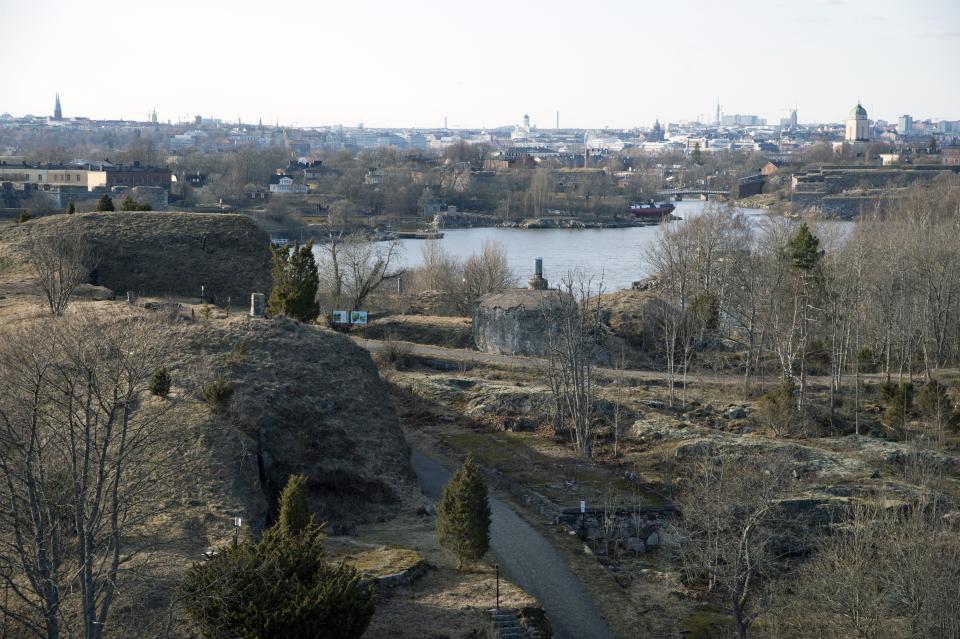
Vallisaari island in the foreground and Helsinki in the background. The City of Helsinki embarked on reopening the island to the general public in 2013. The Helsinki Biennial, an event for contemporary arts addressing nature, oceans, and environmental change was scheduled to be held in 2020 (now postponed to 2021).
Vallisaari island in the foreground and Helsinki in the background. The City of Helsinki embarked on reopening the island to the general public in 2013. The Helsinki Biennial, an event for contemporary arts addressing nature, oceans, and environmental change was scheduled to be held in 2020 (now postponed to 2021).
Photograph by Pekka Vyhtinen. 2019.
Accessed via Helsinki Kuvia on 27 July 2020. Click here to view source.
 This work is licensed under a Creative Commons Attribution 4.0 International License.
This work is licensed under a Creative Commons Attribution 4.0 International License.
Today a fresh challenge has appeared in the form of art and tourism that threatens the biodiversity of the island. In 2019, the City of Helsinki announced an arts biennial on Vallisaari to address the ongoing public debate about the relationship between humanity and nature. The City has also solicited proposals for its further development into an urban recreational and cultural center. However, this entails the construction of water, sewage, and data infrastructure for the projected half a million visitors to Vallisaari. Since the autumn of 2019, to route new cable lines through the island, the terrain has been uncovered and re-structured.
Undoubtedly, part of Vallisaari’s landscape and ecosystem will be transformed by the blasting and excavations. Its topography will be changed and its natural drainage subject to new man-made routes. The underground network of trees—the symbiotic relationships with the soil, the species that depend on this, and the chemical flows—will all be displaced, now entangled with other flows of water and sewage, data, and energy.
How to cite
Bhowmik, Samir. “From Nature to Infrastructure: Vallisaari Island in the Helsinki Archipelago.” Environment & Society Portal, Arcadia (Summer 2020), no. 28. Rachel Carson Center for Environment and Society. https://doi.org/10.5282/rcc/9062.
ISSN 2199-3408
Environment & Society Portal, Arcadia
 This work is licensed under a Creative Commons Attribution 4.0 International License.
This work is licensed under a Creative Commons Attribution 4.0 International License.
2020 Samir Bhowmik
This refers only to the text and does not include any image rights.
Please click on the images to view their individual rights status.
- Engström, Ove, and Taneli Eskola. Kruunun jalokivet: Vallisaari ja Kuninkansaari [The jewels of the Crown: Valisaari and Kuninkansaari]. Finland: Moreeni, 2011.
- Kontiokaari, Seppo. “Suomelle uudet perhoslajit 1990–2009 ja niiden leviäminen eri maakuntiin” [New butterfly species for Finland 1990–2009 and their spread to different provinces]. Baptria 39, no. 4 (2014): 93.
- Kullberg, Jaako. “Tietoa sulkanirkosta (Ptilophora plumigera).” Baptria 39, no. 4 (2014): 119.
- Ranta, Pertti, Antti Tanskanen, Jari Niemelä, and Arto Kurtto. “Selection of Islands for Conservation in the Urban Archipelago of Helsinki, Finland.” Conservation Biology 13, no. 6 (1999): 1293–1300.



